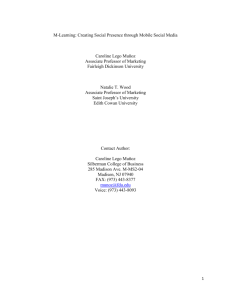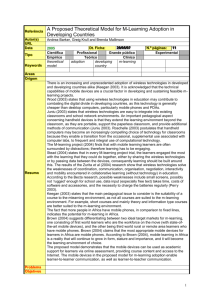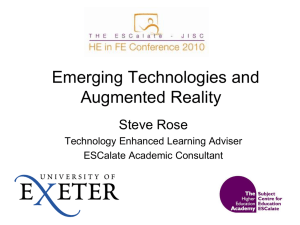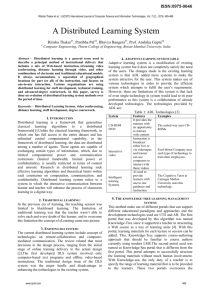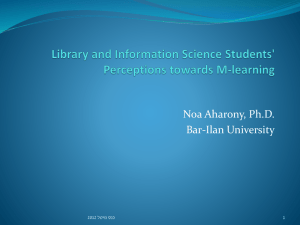Rossyahida Abd Rahman and Mohamad Hisyam Mohd Hashim
advertisement
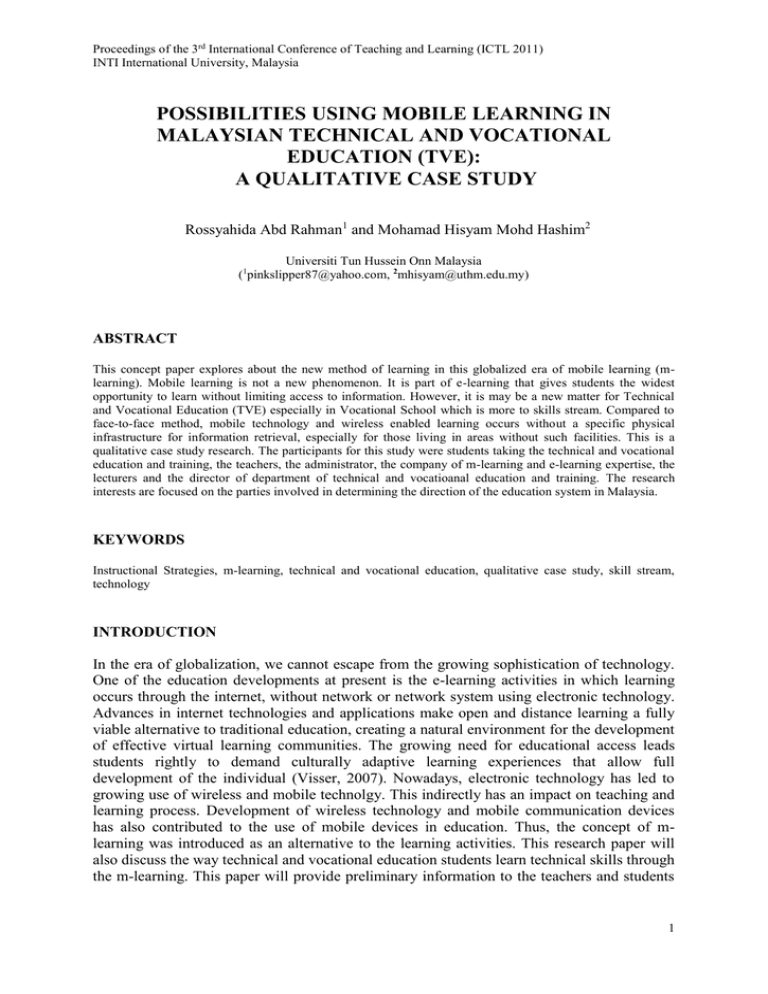
Proceedings of the 3rd International Conference of Teaching and Learning (ICTL 2011) INTI International University, Malaysia POSSIBILITIES USING MOBILE LEARNING IN MALAYSIAN TECHNICAL AND VOCATIONAL EDUCATION (TVE): A QUALITATIVE CASE STUDY Rossyahida Abd Rahman1 and Mohamad Hisyam Mohd Hashim2 Universiti Tun Hussein Onn Malaysia (1pinkslipper87@yahoo.com, 2mhisyam@uthm.edu.my) ABSTRACT This concept paper explores about the new method of learning in this globalized era of mobile learning (mlearning). Mobile learning is not a new phenomenon. It is part of e-learning that gives students the widest opportunity to learn without limiting access to information. However, it is may be a new matter for Technical and Vocational Education (TVE) especially in Vocational School which is more to skills stream. Compared to face-to-face method, mobile technology and wireless enabled learning occurs without a specific physical infrastructure for information retrieval, especially for those living in areas without such facilities. This is a qualitative case study research. The participants for this study were students taking the technical and vocational education and training, the teachers, the administrator, the company of m-learning and e-learning expertise, the lecturers and the director of department of technical and vocatioanal education and training. The research interests are focused on the parties involved in determining the direction of the education system in Malaysia. KEYWORDS Instructional Strategies, m-learning, technical and vocational education, qualitative case study, skill stream, technology INTRODUCTION In the era of globalization, we cannot escape from the growing sophistication of technology. One of the education developments at present is the e-learning activities in which learning occurs through the internet, without network or network system using electronic technology. Advances in internet technologies and applications make open and distance learning a fully viable alternative to traditional education, creating a natural environment for the development of effective virtual learning communities. The growing need for educational access leads students rightly to demand culturally adaptive learning experiences that allow full development of the individual (Visser, 2007). Nowadays, electronic technology has led to growing use of wireless and mobile technolgy. This indirectly has an impact on teaching and learning process. Development of wireless technology and mobile communication devices has also contributed to the use of mobile devices in education. Thus, the concept of mlearning was introduced as an alternative to the learning activities. This research paper will also discuss the way technical and vocational education students learn technical skills through the m-learning. This paper will provide preliminary information to the teachers and students 1 Proceedings of the 3rd International Conference of Teaching and Learning (ICTL 2011) INTI International University, Malaysia in the Vocational School, how technology can be used in teaching and learning technical skills. Technical and vocational education is one of the most important educational avenues for human resource development, particularly for the delivery of skilled and semi-skilled workers. Thus, in addition to the Ministry of Education which is providing technical and vocational education through formal education, there are other government agencies that provide non-formal training outside the formal education system established by law. It aims to train youths and adults for certain jobs or to acquire specific skills. Among the government agencies that provide vocational education and skills training are the Ministry of Human Resources, Ministry of Youth and Sports, Ministry of Agriculture, Tenaga Nasional Berhad (TNB) and Majlis Amanah Rakyat (MARA). Training services provided by the Labour Department under the Ministry of Human Resources has responsibility for managing and implementing training programs and providing consulting services and other services to the company if necessary. In the Sixth Malaysia Plan, the Company Training Institute in Kuala Lumpur and Butterworth has been enlarged and 5 Industrial Training Institutes (ILP) were built to accommodate the rapid increase in the intake of trainees. The courses offered in the ILP are Rises Skill Course, Course Instruction and Technical Training Instructor and Craft. Youth and Sports Ministry is working to equip the youth with technical and vocational skills, business and leadership, and self-reliance skills. To meet the above objectives the ministry has set up several training institutions, such as the Youth Training Centre in Perak, the Leading National Training Center at Old Orchard WA and Youth Training Centres in the state. In addition, it also provides high-level skills training at the Institute of Higher National Youth Ministry in Sepang, Selangor. In addition, the ministry is also providing job training program. Meanwhile, in the context of agricultural development, the Ministry of Agricuture has carried out various non-formal training programs for staff and farmers and youths. The training programs are: (a) (b) (c) (d) (e) Vocational training for youths in the agricultural sector. Leadership training for youths in agriculture for rural development. Training of farmers in modern agricultural techniques and management to enhance the knowledge, skills and efficiency of agriculture as a farmer. General courses in economics and management of agriculture for farmers, housewives, youths, members of Village Development and Security Committee and the Farmers’ Association. The courses of agricultural products such as cocoa, coconut, rice, freshwater fish,goats, sheep, vegetables, coffee and cashew seeds are handled by the Agricultural Research Institute (MARDI). Besides, Tenaga Nasional Berhad (TNB) is providing financial assistance to students and employees who worked to get an education and advanced training in engineering, electrical and mechanical in its efforts to increase the number of qualified and trained staff, whether at the local university and polytechnic outside the state. In addition, TNB has also 2 Proceedings of the 3rd International Conference of Teaching and Learning (ICTL 2011) INTI International University, Malaysia conducted courses and apprentice training at the Training Institute of Sultan Ahmad Shah, Bangi, Selangor as follows: (a) Design Trades Apprentices TNB operates a three-year course in electrical and mechanical engineering at the institute for training apprentices. Many apprentices were selected from semi-skilled workers who are currently serving in the TNB. Apprentice courses are producing the skilled workers such as Electrical Chargeman, Electrician, Mechanical Chargeman, Welder, and Motor Mechanic. (b) Orientation Course TNB in collaboration with the Association of Ex-Servicemen, and the Ministry of Defence, provide these soldiers trainings in courses of their choice. These courses prepare them to work as an electrician, wireman mechanics, welders or general workers and other trades. Meanwhile, Mara was established to provide encouragement, guidance and training to the natives to take part actively in the trade and industry. To achieve this objective other that traning Mara provides scholarships and education loans, it also provides vocational training to young indigenous MARA (IKM). Besides, MARA has also established the MARA Institute of Commerce and Pusat Giat Mara. Therefore, it is clear that technical and vocational education provided by the formal education system through the Ministry of Education and vocational education as well as through nonformal education provided by government agencies and statutory bodies is equally important as they complement one another to train skilled and semi-skilled workers needed by the industrial sector. Hence, without the cooperation of both parties, the aim to train more and more skilled workes for the man power needs will be diffucult. LITERATURE REVIEW The cultural dimension of learning is new in this globalization era. This is because there is a culture where the learning process and technology that is associated with multimedia or multi-cultural teaching. Therefore, it is hoped that the learning culture must be viewed holistically in order to develop appropriately. The definition of culture here refers to the cross cultural theory where cultural dimensions have been implemented in studying human behavior. The culture of learning has been changing from time to time in line with global technological developments. This culture begins with learning using the textbook. Then, it turned to the computer aided learning and when the technology grows, the use of the internet in teaching and learning become more widespread. Internet can be applied in education through activities either in their daily work or in the teaching and learning process. There are signs of construction the new technology to increase learning performance. Internet revolution is not only to search for global information but to build and strengthen the ties between human beings to communicate. Electronic mail (e-mail) is one of the internet services that is widely used. In addition, listservs, Usenet and Internet Chat is a service that allows people to communicate with anyone using a computer.Therefore, 3 Proceedings of the 3rd International Conference of Teaching and Learning (ICTL 2011) INTI International University, Malaysia teachers and students can join discussion groups to ask questions, discuss questions and share experiences and knowledge online. There is a lot of interestings and differents for teachers and students in the internet. Information was available on the website in the form of database, documents, government information, online bibliographies, publications and computer software. Most of the information provided is updated and available for free and is quickly accessible by anyone. Teachers and students can publish materials on the internet. The process of publication through the internet is faster and cheaper than through the traditional channels. The work of teachers and students can be sent to the internet so the world can read them or make an assessment of a lesson developed. The internet has enabled the service and training programmes delivered via online and remotely accessible. E-learning or online learning is learning through the implementation of technology support services such as telephone, audio, video, satellite transmission or computer. However, m-learning or mobile learning has been used to support e-learning. In recent years, the rapid growth of mobile technologies is promising a new revolution that might be comparable with the Web. In brief, one of the major advantages for m-learning is where learning can previously occurred only in front of a computer terminal, in the classroom, laboratory or at home, it is now able to occur in the field, or at any location where the mobile device is fully functional (Sharma & Kitchens 2004). Details about the operation of m-learning are explained below. M-Learning can be defined as the ability to perform training and assessment tasks using any device connected to any network. At present, mobile learning is defined as the technology in learning. This is different from e-learning, where the users can use the technology due to its mobility and not being constrainted to the places and areas to get the learning information. According to Quinn (2002), m-learning is a learning that is carried out through mobile devices and analyzed as Personal Digital Assistant (PDA), mobile phones and palms. Keegan (2005) state that many researchers provide a complex definition of m-learning. For him, mlearning is the provision of education and training using the PDA, Palmtops, mobile computers, smart phones and mobile phones. In conclusion, m-learning is a mode of learning and training which is carried out using mobile technologies devices such as laptops, PDAs, iPad, Play Station Portable (PSP) and mobile phones that allows learning occurs everywhere and at anytime. M-learning also gives the students a head start in the IT revolution, equipping them with skills not only to do well in their studies but also to excel in their future careers. It allows students to use their own laptop computer for their studies on campus, thereby making student learning mobile. In Malaysia, the method of m-learning is not impossible to implement because most students nowadays have their own portable devices like mobile phone, ipod, PSP and so on. Moreover, the provisions of broadband facilities provided by the telecommunications companies have been widespread in Malaysia. Recently, an article in the Utusan Malaysia (2011) states that 430 broadband centers will be set up in rural areas and remote areas across the country within the next two years. These facilities are provided specifically for students and youths. Therefore, there will not be any problem to access the internet and to support mlearning. 4 Proceedings of the 3rd International Conference of Teaching and Learning (ICTL 2011) INTI International University, Malaysia Tools for M-Learning There are varieties of mobile devices that support m-learning. Each of the tools has different capabilities and functions but what is the important is that equipment has the ability to support wirelesss applications. The following are the types of mobile devices that can support m-learning: PDA (Personal Data Assistants) functions as a personal digital assistant which is very small sized and capable of playing a variety of multimedia files. PDA uses the Palm operating system and Microsoft Pocket PC. Small notebooks are light, easy to carry, and capable of functioning as desktop computers. Most support wireless communication. Cellular phone allows users to communicate with one another from anywhere and anytime. Users can also send and receive SMS and MMS to other users. There are also cellular phones that can access the internet via WAP or GPRS technology. Smart phone is a combination of cellular phone and PDA. This phone uses symbian software, windows mobile and other mobile software. It is also equipped with internet access and the ability to support multimedia applications. 3g phone is the 3rd generation of mobile phone that has the ability to transfer four times better than the ordinary cellular phones. It can transmit information up to 2 megabits per second in addition to supporting full video and multimedia. The Advantages of M-Learning M-learning has proven that it can be very useful to support learning in other countries and now it is introduced in Malaysia where several institutions of higher education have integrated this technology in their teaching curriculum. There are some advantages in the use of m-learning such as : 1. Learning process can occur anywhere at anytime and is not limited to the classroom. 2. System of m-learning is very interesting because students can create an interactive training using a mobile phone that has an internet access anytime an anywhere during their free time. 3. Students can easily download notes by using the internet service provided by a mobile phone subscription. Therefore, the downloading process can be done anywhere and at anytime. 4. Teacher can write quizes for students at any time by simply inserting the question and determine the time taken for the quiz. 5. A test that is carried out through mobile devices has been found to be more effective and efficient. 6. The multimedia elements that can integrate audio and video is able to attreact student’s interest in the use of m-learning. 5 Proceedings of the 3rd International Conference of Teaching and Learning (ICTL 2011) INTI International University, Malaysia The findings of the Attewell’s (2005) study in formulating the project MLearn 2001 suggest that the use of m-learning can have a positive impact on several areas: 1. M-learning helps students to improve the literacy and numeric skills to identify their true capability. 2. M-learning can be used to encourage both independent learning and experience sharing of learning experiences. 3. M-learning can help the students identify things that need help and support. 4. M-learning can help to use the information and communication technology and can help to reduce the gap between mobile phone literacy and information technology literacy. 5. M-learning helps the students to refuse some of the formalities in the learning experience. 6. M-learning helps the students to maintain focus on learning for a longer time period. 7. M-learning helps to increase the self-esteem of students. 8. M-learning helps in increasing the self-confidence of students. These positive effects when applied in the Malaysian Technical and Vocational Education learning environment will improve students’ performance in all aspects to be achieved. The Disadvantages of M-Learning In a research paper conducted by Singh and Zaitun (2006), several disadvantages have been identified when integrating mobile devices in the Malaysia education system: 1. 2. 3. 4. 5. The storage capacity for palm talk and mobile phone are very limited. Broadband speeds may be reduced when the number of users increases. PDA and mobile phones are not durable compared to personal computer. The batteries should be charged often and if not done correctly, the data may be lost. Limitation of small screen size. Limited exposure to mobile technology is also seen to be one of the problems in the development of m-learning methods. Early exposure, especially to students is important for students’ to understand and then adopt the method of m-learning. The role of teachers is also seen to be very important in the development of m-learning. Teachers should be introduced to the m-learning prior to this method before it is introduced to the students. Poor control of m-learning could be the cause of the ineffectiveness of the whole m-learning. Relationship Between e-learning and m-learning According to Brown (2003), m-learning is a subset of e-learning. E-learning is a macro concept that involves online learning environment and m-learning. The diagram below indicates clearly the relationship between e-learning and m-learning. Through the diagram can be seen that m-learning is a subset of e-learning while e-learning is a subset of distance learning. While distance learning is a subset of a flexible learning. 6 Proceedings of the 3rd International Conference of Teaching and Learning (ICTL 2011) INTI International University, Malaysia Flexible Learning Face-to-face Learning Distance Learning E-Learning Online Learning M-Learning Distance Learning Based on Paper Figure 1. Relationship between e-learning with m-learning (Brown, T. H. 2003). A Model for Analysing Mobile Learning This model is designed to describe an application of cultural-historical activity theory to analyse the activity system of mobile learning. It describes the dialectrical relationship between technology and learning. In the tradition of Activity Theory, it is analysed that learning is a cultural-historical activity system, mediated by tools that both constrain and support the learners in their goals of transforming their knowledge and skills. In analysing the activity of mobile learning it has helped to separate two layers of toolmediated activity. The semiotic layer describes learning as a semiotic system in which the learner’s object-oriented actions such as actions to promote an objective are mediated by cultural tools and signs. The technological layer represents learning as an engagement with technology, in which tools such as computers and mobile phones function as interactive agents in the process of coming to know, creating a human-technology system to communicate, to mediate agreements between learners as with spreadsheets, tables and concept maps and to aid recall and reflection as with weblogs and online discussion lists. 7 Proceedings of the 3rd International Conference of Teaching and Learning (ICTL 2011) INTI International University, Malaysia Technology Tool (mobile learning technology) Gemiotic Tool (learn-space) Object Technological (access to information) Semiotic (knowledge and skills) Technological (technology user) Semiotic (learner) Changed Object (revised knowledge and skills) Control Technological (learner-computer interaction) Context Technological (physical context) Communication Technological (communication channels and proadcast) Semiotic (social rules) Semiotic (community) Semiotic (communication) Figure 2. A Model for Analysing Mobile Learning (2005) Source: Mike Sharples, Josie Taylor, Giasemi Vavoula, Towards a Theory of Mobile Learning Control The control of learning may rest primarily with one person, usually the teacher or it may be distributed among the learners. Control may also pass between learners and technology for example in a dialogue for computer-based instruction. The technological benefit derives from the way in which learning is delivered, whether the learners can access materials when convenient and whether they can control the pace and style of interaction. These are issues of human-computer interaction design. However, technology use occurs within a social system of other people and technologies. Social rules and conventions govern what is acceptable for example how to use e-mail, who is allowed to e-mail whom and what kinds of document format should be used. A person’s attitudes to technology can be influenced by what others around them think about it for example whether they are resentful at having to use the technology or keen and eager to try it out. And individuals and groups can also express informal rules about the way they like to work and learn. Communication The dialectrical relationship between the technological and semiotic layers is perhaps the easiest to see in relation to Communication. If a technological system enables certain forms of communication such as e-mail or texting, learners begin to adapt their communication and learning activities accordingly for example, children are increasingly ‘going online’ at home, creating networks of interaction through phone conversation, texting,e-mailing and instant messaging that merge leisure and homework activities into a seamless flow of conservation. 8 Proceedings of the 3rd International Conference of Teaching and Learning (ICTL 2011) INTI International University, Malaysia As they become familiar with the technology they invent new ways of interacting such as ‘smilies’, text message short forms and the language of instant messaging that create new rules and exclusive communities. This appropriation of technology not only leads to new ways of learning and working, it also sets up a tension with existing technologies and practices. For example, children can subvert the carefully managed interactions of a school classroom by sending text messages hidden from the teacher. On a broader scale, technology companies see markets for new mobile technology to support interactions such as file sharing and instant messaging. Thus, there is a continual co-evolution of technology and human communication with each new development creating pressures that drive the next innovation. Context The context of learning is an important construct, but the term has many connotations for different theorists. From a technological perspective there has been debate about whether context can be isolated and modelled in a computational system or whether it is an emergent and integral property of interaction. Work for the MOBIlearn project has developed an interactional model of context for mobile learning (Lonsdale, Baber & Sharples, 2004). Context also embraces the multiple communities of actors, both people and interactive technology who interact around a shared objective. Model of Instructional System Design Tsai, Young and Liang (2005) has developed a model of “Instructional Systems Design (ISD) model based on the ADDIE model of instructional design and ASSURE model. Analyzed the students’ need and mobile situation Evaluate the effects of m-learning Learning intergration based on mobile technology Student Teacher Technology M-learning Implement the instructional activities Situation n Content Design of m-learning teaching strategy Design and development of M-learning Figure 3. Model of Instructional System Design (2005) Source : I.H. Tsai, S.S.C. Young & C. H. Liang. Exploring the course development model for the mobile learning context. A preliminary study. Papers Fifth IEEE International Conference on Advanced Learning Technologies (ICALT’05). Kaohsiung, Taiwan. 9 Proceedings of the 3rd International Conference of Teaching and Learning (ICTL 2011) INTI International University, Malaysia There are six steps in the ISD model which are: (i) (ii) (iii) (iv) (v) Analysis of students’ needs and the mobile situation, including analyzing the needs of mobile to integrate mobile technology in learning, students’ readiness to use technology to analyze, collect and analyze various sources of learning outside the classroom learning environment. Integration of mobile technology-based teaching, including the suitability of mobile technology such as weight, screen-size resolution and other specifications as well as analyze and develop a wireless environment for use outside the classroom. The design of m-learning strategies includes planning the provision of learning materials for m-learning for students to focus on the learning environment that is open. Design the development of the content of m-learning materials, including the preparation of learning plans, providing objectives, the selection of appropriate instructional media, developing multimedia learning materials and develop a timetable and cost of labor. Implement the learning activities, including organizing the entire m-learning activities in accordance with the six teaching steps by Gagne. Assess the impact of m-learning include using various forms of assessment to evaluate the effect of including tests of qualitative reports. Constructivism Theory in M-Learning In this study, researcher chose a constructivist approach in the m-learning approach because this theory emphasizes the active involvement of students. This theory emphasizes the behaviour of students (hands-on) and emphasizes the mental activity (minds-on) students. According to the views of constructivism, students have their own ideas about the occurrence of the phenomenon before entering the classroom. Students construct their own reality or reality-based perception to interpret their experiences. M-learning based on constructist theory emphasizes the development of a software that has a different perspective (multiple perspectives), such as the use of collaboration and communication tools and access to data to allow students to learn from different perspectives. Student-centered learning is students’ ability to apply, completely free to choose topics to study, generating their own questions and plan their own learning. According to Baharuddin et al. (2002), constructivist theory of strategies to promote the discovery of the m-learning is developed. Students should be given activities that allow students to meet their own educational principles. Teachers are not supposed to help by providing principles to assist the process of teaching students to be more effective. In this context, students are helped to make a generalization and transfer learning to other situations by using the same concept. 10 Proceedings of the 3rd International Conference of Teaching and Learning (ICTL 2011) INTI International University, Malaysia Possibilities Using Mobile Learning Mobile learning implies several possibilities for learning. Learners with a mobile device can go to a field to interact with other people, and participate in physical environments for gaining concrete knowledge, instead of sitting in front of a computer screen. When mobile learning first arrived on the scene about 10 years ago, it was thought to be like e-learning except on a smaller screen. That is, educational material was packaged as courses, and tests were given on mobile phones. 10 years later, there are many new developments in mobile learning, some of which have the potential of being highly disruptive of how teaching and learning has traditionally been carried out. Technology is one of the main drivers of the existing mixed mode and flexible learning environment in schools and universities today. There is a need to develop instructional strategies that marry most effectively traditional approaches to teaching and learning with more contemporary concepts of e-learning, flexible and online learning and virtual class or virtual campuses. Instructional strategies determine the approach a teacher may take to achieve learning objectives. Strategies can be classed as direct, indirect, interactive, experiential or independent. Decision making regarding instructional strategies requires teachers to focus on curriculum, the prior experiences and knowledge of students, student interests, student learning styles and the developmental levels of the student. Such decision making relies on ongoing student assessment that is linked to learning objectives and processes. M-learning has been used to help those students who are outside formal education, who have abandoned their studies, teenagers no longer motivated by traditional curricula, and to prevent the risk of leaving school. By using mobile learning, students could send text messages, keep in touch with friends, play computer games and learn by doing which can make the learning process more enjoyable with the help of the appropriate instructional strategies. The portability and versatility of mobile devices has significant potential to promote an instructional strategies shift from traditional teacher-centered to student-centered and participatory learning environments. Students can participate in learning scenarios that utilizes the mobility, portability and context-sensitivity of mobile devices. They can act as active self-directed students, rather than passive students following one single path of learning. The relationship between the mobile and the student depends on the medium and not on the environment. So the user is no more constrained to have a PC to optimize his/her time for learning because the mobile is “comfortable” and easy to access to learning. Interaction is vital in learning and the place does not interfere with learning. M-learning can substitute the PC/laptop which is not always within reach, the mobile can be used for the acquisition of knowledge, may help to speak in a foreign language, may help students with difficulties in a more appealing and motivating way. This case clearly shows that, by using mobile learning, students in TVE will be through the teaching and learning process more effectively. METHODOLOGY Proposed Data Collections/Instruments This is a qualitative research. Data collection methods to be used is an unstructered interview conducted in-depth, writing in the note field, document analysis and observations. Interviews were conducted by face-to-face, either individually or grouping. The participants for this 11 Proceedings of the 3rd International Conference of Teaching and Learning (ICTL 2011) INTI International University, Malaysia study were students taking the technical and vocational education and training, the teachers, the administrator, the company of m-learning and e-learning expertise, the lecturers and the director of department of technical and vocatioanal education and training. Data Analysis Data will be analyzed based on the concept of qualitative data collected and will be compiled on a systematic basis, such as arraging data in tubular form. The detail this study will be made on the reccomendations of Merriam (1998). The analysis made in two stages, namely analysis, during and after data collection. After collecting data, Nvivo 8 software will be use to organise data.. SUGGESTIONS Education based m-learning course is suitable for Malaysia. Paradigm, we respect this new technology should be changed so that it can be realized. Convenience of modern educational methods and tools should be tested over the collective to ensure students can experience the excitement of learning where without being limited by, place and time. Limited exposure to mobile technology must be terminated by holding a special class in respect of this technology. Therefore, the opportunity for students to understand the power of technology can be improved. Extensive research may be conducted, particularly in overcoming the identified problems and improve the opportunities available to strengthen the m-learning in Malaysia. Environmental education in Malaysia may be different from other countries, so the connection can be implemented to realize the environmental of m-learning. Extensive research in this area have been identified to develop the education sector as a whole, especially in technical and vocational education. CONCLUSION M-learning has come to play an important role in learning, especially for technical and vocational educatioan. The existence of mobile and wireless technology has made it reality. Student is free to learn and acquire information to make m-learning very well-liked. Through the technology and the ability to have mobile devices, m-learning is not something that is difficult to be implemented in Malaysia. Commitment of all stakeholders including the government, service providers, instructional designers, teachers and students is needed. REFERENCE Attewell, J. (2005). Mobile Technologies and learning: A technology update and m-learning project summary. Learning and Skills Development Agency. London. Baharuddin A., Noraffandy Y., Jamaluddin H. & Zaidatun T. (2000). Teknologi Pendidikan : Siri Modul Pembelajaran. Skudai, Johor :Universiti Teknologi Malaysia. 12 Proceedings of the 3rd International Conference of Teaching and Learning (ICTL 2011) INTI International University, Malaysia Brown, T. H. (2003). Towards a model for m-learning in Africa. International Journal on E-Learning, 4(3), 299-315. Keegan, D. (2005). The incorporation of mobile learning into mainstream education and training. Kertas kerja dibentangkan di 4th World Conference on Mobile Learning. Cape Town, South Africa. Lonsdale, P., Baber, C. & Sharples, M. (2004). A Context Awareness Architecture for Facilitating Mobile Learning. In J. Attewell & C. Savill-Smith (Eds.), Larning with Mobile Devices: Research and Development (pp. 79-85). London: Learning and Skills Development Agency. Mashkuri Hj. Yaacob (2003). Architecture of m-learning system. Kertas kerja dibentangkan di International Conference on Mobile Learning. Universiti Malaya, Kuala Lumpur. Merriam, S.B. & Caffarella. R.S. 1998. Learning in Adulthood: A Comprehensive guide. SanFrancisco: Jossey-Bass Publishers. Quinn, C. (2002, Fall). MLearning: Mobile, wireless, in you pocket learning. Linezine. Retrieved on 2 Januari 2010 from: http://www.linezine.com/2.1/features/cqmmwiyp.htm. Sharples, M., Vavoula, G. N. & Taylor J. (2005). Towards a Theory of Mobile Learning. University of Brimingham & Open University, UK. Singh, D., Zaitun, A. B. (2006). Mobile Learning in Wireless Classrooms. Malaysian Online Journal of Instructional Technology (MOJIT), 3(2), (pp. 26-42). Tsai, I. H., Young, S. S. C. & Chia-Hang Liang, C. H., (2005). Exploring the course Development model for the mobile learning context: A preliminary study. Kertas Kerja Fifth IEEE International Conference on Advanced Learning Technologies (ICALT’05). Kaohsiung, Taiwan. Utusan Malaysia, 19 Januari 2011. 430 Jalur Lebar bakal Wujud di Pedalaman. Visser, J. (2007). Learning in a global society. In M. G. Moore (Ed.), Handbook of distance education (2nd ed.). Mahwah, NJ: Lawrence Erlbaum Associates. 13


